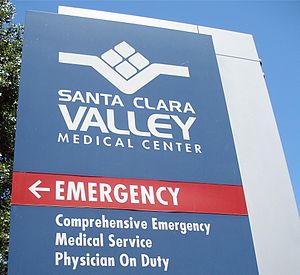
English: A roadside sign at Santa Clara Valley Medical Center in San Jose. (Photo credit: Wikipedia)
Like other buildings that operate 24 hours per day, hospitals use a great deal of energy. As a result, there has been much focus in recent years by hospital administrators and building managers on reducing energy consumption and lowering operating costs since hospitals use an estimated 5 percent of all energy consumed in the United States.
But a recent study in the UK complicates the issue somewhat because it points out that by making hospitals “tighter” and more energy efficient, patients may become more susceptible to airborne infections and germs. The study, which was conducted at the University of Leeds, attempted to show how airborne infections might be passed in an average hospital unit. The researchers released balloons filled with carbon dioxide in an effort to mimic the spreading of germs or an infection.
With the use of smoke sticks, researchers were then able to follow the route of the fake infection. The results were that the airborne infection risk was low when windows were open and increased by up to four times when the windows were closed to save energy. According to the lead investigator, it’s important to provide alternative ventilation systems when sealing up buildings for energy efficiency to reduce the risk of airborne infections.
Grab the whole story here: http://www.goodway.com/hvac-blog/2013/06/iaq-building-performance-energy-efficiency-can-affect-hospital-infection-rates/
Speak Your Mind